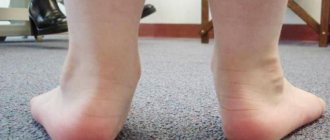The ankle is an anatomical part of the lower limb, which provides free movement of the foot in three planes: sagittal, frontal and horizontal. The ankle is located at the bottom of the lower leg and is part of the ankle joint. Its lateral and medial parts protrude outward on either side of the Achilles tendon.
Structure of the human ankle
The first detailed description of the location and structure of the ankle can be found in the notes of the great anatomist and artist of the 15th century, Leonardo da Vinci. He pointed out where the human ankle was located, drew in great detail all the anatomical features of the lower leg and its joint, and signed all their names in Latin.
In Latin the ankle or ankle is called "malleolus".
Anatomical structure of the ankle
The ankle, or ankle, is formed by the bony processes of the tibia and fibula. Based on this, in the anatomical structure they distinguish between the lateral malleolus, which is formed by the tibia, and the medial malleolus, formed by the fibula.
In the middle between the bone formations of the ankle is the talus bone. It is a dense structure with three articular surfaces. It is these surfaces that form the ankle joint and ensure free movement of the foot.
What is the ankle, where is it located and what is it responsible for?
The ankle is a bone formation located between the lower leg and foot area. In other words, that same protruding bone near the heel. In the ankle joint, there are anatomically two ankles - external and internal.
Do not confuse the ankle with a joint or muscle, as it is the formative part of the lower leg and allows it to bear the load of the body.
The fact is that when moving, the entire weight of the body places emphasis on the legs, and the ankle serves as a link in the system, thanks to which it is easier for a person to move, make turns in different directions and correct the movement of the foot.
Physiological function of the ankle
The movement of the foot is ensured by many ligaments.
The ankle is a surface to which many ligaments are attached that support the foot.
Ankle ligaments:
- Inferior retinaculum of the extensor tendons. This ligament is located directly above the ankle joint and goes around it like a strap. Its width is just over a centimeter, so it is very strong. Most often injured by a direct blow from a blunt or sharp object. Local swelling and hemorrhage occur at the site of inflammation. The function of the foot is not impaired, but straightening the toes can cause pain at the site of injury.
- Calcaneofibular ligament. A short and wide ligament located on the side of the ankle. It originates from the lower pole of the fibula and attaches to the calcaneus. She is often injured when walking in high-heeled sandals. This is due to the openness of the foot and its free placement in the shoe last. Most ankle ligaments can withstand loads of more than 450 kg. Therefore, with a sudden load, pieces of bone to which the ligament is attached sometimes tear off.
- The anterior tibiofibular ligament (interfibular syndesmosis) is a tendon located between the fibula and tibia bones. It is very rarely injured, but in the event of a dislocation of the ankle, it often tears outwards.
- The medial (deltoid) ligament is located between the tibia and the anterior articular surface of the talus. The ligament ensures that the foot is held in the sagittal plane and prevents dislocation of the ankle joint in this direction.
Muscles that attach near the ankle:
- Long fibula. This is a pronator, which ensures the movement of the foot to the side. It originates on the side of the knee joint just below the hip.
- The peroneus brevis muscle is medial to the peroneus longus muscle and performs the same function.
- The tibialis anterior muscle is located directly in front of the lower leg near the periosteum. It functions as an extensor of the foot and big toe.
Thanks to this complex structure of the ankle, the foot can move in three planes:
- Sagittal.
- Frontal.
- Horizontal.
All these and many similar situations can easily cause serious diseases of the ankle ligaments:
- Arthritis of the ankle joint.
- Arthrosis of the ankle.
- Chronic tendon injury.
- Synovitis.
- Ankle fracture (severation of the bone along with the attached ligament).
Without timely medical attention, these conditions can significantly reduce the quality of life and lead to lameness and periodic pain in the leg.
Important! An initially weak foot, which has a sign of flat feet, gradually leads to a valgus change in the shape of the leg. The legs take on an X-shape.
Valgus is a very dangerous condition that can limit a person's activity due to damage to the knee and ankle joint.
Ankle injuries
Traumatic ankle injuries rank first among all lower extremity injuries. This is due to the high loads placed on the joint of the foot and lower leg.
When force is applied to the ankle area, most often it is not the ankle itself (bone tissue) that suffers, but its ligamentous apparatus - partial or complete rupture of the ligaments occurs. Under the influence of higher loads, the bone tissue cannot withstand it - an ankle fracture occurs.
Most often, traumatic injury is associated with a strong and sharp roll of the foot inward or outward, or rotation of the shin around its axis when walking or running. Pronation (turning the foot inward) injury is recorded more often than supination (turning it outward) and rotational (turning around its axis), and accounts for three-quarters of ankle injuries.
Twists of the foot and sharp turns of the leg relative to the foot are accompanied by damage to the ligaments, which can lead to dislocation or, if they are significantly strained, a fracture.
Other causes of injuries to this bone include landing on the feet (especially the heel area) from a great height, or a strong blow to the ankle.
The following are particularly susceptible to ankle injuries:
- athletes;
- persons engaged in heavy physical work;
- persons with congenital or acquired weakness of the ligamentous apparatus.
Acquired ankle ligament weakness most often occurs as a result of a sedentary lifestyle and sedentary work.
Ankle injuries are often caused by wearing high-heeled or high-platform shoes, especially when walking on uneven or slippery surfaces.
Arthritis of the ankle
Arthritis of the ankle joint on an x-ray
Sometimes an injury to any ankle leads to a violation of the integrity of the skin on it. This can cause infection of the soft tissue area with infectious agents (seen in the photo).
As you know, ligaments have a very poor blood supply, which slows down the development of the infectious process. Within 10-15 days, inflammation occurs in the area of injury, which affects the synovial membranes of the talus. Gradually, inflammation leads to destruction of the articular surface, impaired movement in the joint and its ossification.
Signs of arthritis:
- Redness of the skin over the joint.
- Swelling of the joint.
- Pain with movement and at rest.
- The skin over the joint is hot.
Interesting! Sometimes small bumps appear in the area of the inflamed joint, which indicate reactive rheumatoid arthritis. This sign requires urgent consultation with a specialist, because delay can affect the effectiveness of treatment.
Features of treatment
If, after examination by a doctor and diagnostics, minor ligament damage is confirmed, then it is necessary to ensure maximum rest for the sore leg. Cold compresses are indicated. Ice is applied to the sore spot during the first 24 hours after injury. If necessary, painkillers are prescribed and orthoses are worn to fix the ankle. In severe cases, when the ligaments are torn, surgical treatment is performed.
In case of a fracture, a plaster cast is required. Strong painkillers are prescribed to relieve pain. If bone displacement is confirmed, surgery is performed. An ankle fracture requires professional treatment. Otherwise, foot function may be impaired.
With correct treatment, it will take 6-8 weeks for the bones to heal in an ankle fracture. During this period it is necessary to wear a cast. You should also avoid any stress on the injured leg. After the cast is removed, you will need to wear special shoes for a certain time and periodically take x-rays to monitor the recovery. The duration of complete rehabilitation usually takes about a year. During the recovery period, calcium-rich foods should be included in the diet. Massage and physical therapy are also indicated.
Arthrosis of the ankle joint
Deformity due to ankle arthrosis
Unlike arthritis, arthrosis does not cause ossification. A joint affected by arthrosis becomes deformed and painful, but retains mobility.
Signs of arthrosis:
- Starting pain. Before walking, you need to stand, “stretch your legs,” and only then will you be able to walk freely.
- Slight increase in skin temperature over the joint.
- Swelling of the joint.
- Enlargement and deformation of the joint.
- The frequency of exacerbation of the disease, which may be associated with weather conditions, physical activity or injury.
Treatment of arthrosis and arthritis involves the use of local and general anti-inflammatory and painkillers.
Electrophoresis or treatment with pulsed currents gives a good effect. The basis of treatment in this case is the delivery of drug molecules to the site of inflammation using direct or alternating electric current.
Swelling of the ankles
A fairly common pathological condition is swelling of the ankles. They occur without exposure to any traumatic factor. In most cases, this is due to excess weight and a sedentary lifestyle. Due to increased stress, edema often occurs during pregnancy. When such symptoms appear, it is important to dose out physical activity and drink less fluid.
Swelling of the ankles can be a symptom of various diseases: heart, kidney and liver. In addition, urinary tract infections are a common cause of pathology. Swelling of the ankles may indicate the onset of venous insufficiency. In this case, after a certain time, changes in the appearance of the skin will appear, and in severe cases, ulcers will appear and the risk of infection will increase.
If swelling of the ankles occurs, you should immediately contact your local physician. To treat swelling of the ankles, the cause of the pathological condition must be established. After this, measures are taken to treat the specific disease. In any case, therapeutic exercises can stabilize the condition. It is also important to wear comfortable orthopedic shoes when swelling occurs. For persistent swelling, herbal diuretics are prescribed. Foot baths and massage are recommended at night.
Ankle fracture
An ankle fracture is a serious and dangerous injury that can cause dysfunction of the joint, contracture of the leg muscles or cauda equina.
Leg pain due to ankle fracture
In the area of the ankle itself there are many nerve plexuses and blood vessels that provide nutrition to the foot and its movement.
Most often, the lateral and medial malleolus are fractured at the same time. Depending on the mechanics of the fracture, one breaks more, the other less.
If there are soft tissues between the bone fragments, then it is a displaced fracture. It requires treatment in a hospital using external or internal methods of osteosynthesis (bone plates or Elizarov method).
Fractures
Ankle fractures can occur for a variety of reasons. Direct injuries occur upon impact. Most often, this occurs during an accident when a heavy object accidentally falls on the leg. Indirect fractures are more common. They usually occur when the leg twists. In this case, the injury is accompanied by the formation of bone fragments and dislocation of the foot and sprained ligaments. As a rule, it occurs when falling on ice or a slippery floor, walking on an uneven surface, etc.
If the fracture did not cause displacement of bone fragments and severe sprain of the ligaments, then swelling and tolerable pain are noted against the background of difficulties with joint mobility. In more severe cases, there is intense pain and an absolute inability to step on the injured leg. In addition to swelling, bruising is often present in the ankle area. With an open fracture, there is a wound through which bone fragments are visible.
Rehabilitation after an ankle fracture
When an ankle is fractured, the function of several structures is disrupted. Blood vessels are injured, which leads to circulatory failure. Nerve endings are injured, which causes hypotonicity of the muscles and swelling of the soft tissues.
To restore full function of the foot, proper comprehensive rehabilitation is necessary.
- Special physical exercises for the sore leg during each period of treatment.
- General strengthening exercises to increase the overall tone of the body muscles.
- Physiotherapeutic procedures throughout the entire rehabilitation period.
- Gradual increase in axial load on the sore leg from 5-7 days.
- Using an instep support as a preventive measure for secondary flat feet.
- Rolling a hard roller with your foot every day for a year after the injury.
- A massage course to improve blood circulation and lymph flow in the lower limb.
The ankle has no counterpart on the forearm. This is a complex and powerful device that allows a person to walk, run and jump. By maintaining a normal weight, regular moderate physical activity, and wearing arch supports, you can significantly reduce the risk of developing inflammatory ankle diseases.
Ligament damage
As a result of excessive stretching, either a complete rupture of the ligament or a partial rupture can occur; the latter is often (and not very correctly) called a sprain. Even with micro-tears of the connective tissue in the ligaments, hemorrhages can occur, intercellular fluid can accumulate, resulting in pain that intensifies with exercise - standing, walking.
Sometimes unusually long walking in people leading a sedentary lifestyle leads to a sprain; in this case, pain occurs without visible injury (twisting the foot, impact), although in fact there is damage to the connective tissue.
Signs of more significant ligament damage include:
- swelling of the ankle, and in case of serious injuries – also of the lower leg;
- impairment or complete loss of ankle mobility.
For minor ligament injuries, treatment consists of providing maximum rest to the affected leg and applying cold compresses during the first 24 hours after the injury. In more severe cases, it may be necessary to take painkillers, wear orthoses of various fixations, or undergo surgery.
If you suspect ankle ligament damage, you should consult a doctor as soon as possible. Even if mobility in the ankle is not lost, pain (especially if it does not subside within two days) and swelling may indicate a bone fracture.











